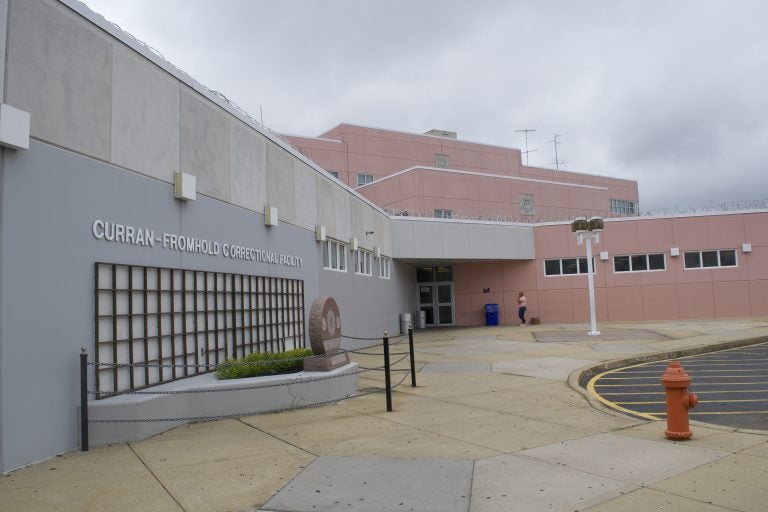Philadelphia jail scrambles to find doctors who can prescribe addiction treatment
Due to federal prescribing limits, the men's prison has found itself in a tough position: It has more people who need the drug Suboxone than doctors who can prescribe it.
Listen 2:07
Medical officials at Philadelphia Department of Prisons say they are struggling to meet the demand for Medication-Assisted treatment among inmates as the result of federal prescription limits and unexpected staff turnover. (Nina Feldman/WHYY)
Almost a year ago, the Philadelphia Department of Prisons began offering buprenorphine to its opioid-addicted inmates. The drug, widely known by its brand name, Suboxone, is a low-dose opioid designed to curb withdrawal and prevent cravings. When combined with therapy, it is considered the gold standard for opioid-addiction treatment.
But due to federal prescribing limits, the department has found itself in a tough position: It has more people who need the drug than doctors who can prescribe it.
Of the 30,000 inmates expected to be admitted to Philadelphia’s county jail this year, officials estimate that about 6,000 will be addicted to opioids. For many, their time in jail may be their only interaction with medical professionals. From a public-health perspective, therefore, incarceration can present an opportunity to connect those addicted to opioids with treatment — especially if that treatment is continued after release from prison.
In February 2018, the Philadelphia Department of Prisons launched a pilot program offering buprenorphine to women addicted to opioids in Riverside Correctional Facility, the women’s prison. Under the umbrella of medication-assisted treatment, known as MAT, buprenorphine – along with methadone maintenance and naltrexone, a long-lasting injection – are considered the standard of care for addiction treatment. The department’s chief of medical operations, Bruce Herdman, said that of those women eligible to participate, 80 percent want the treatment, amounting to roughly 70 women at a time on buprenorphine.
In September, the Department of Prisons expanded its treatment program to the men’s prison, where about 230 eligible inmates elect to be on buprenorphine at a given time. The drug is administered under the supervision of medical staff, once daily. When inmates leave the prison, they are sent with a prescription to refill the drug so they can continue treatment.
In mid-January, the men’s prison hit a snag. John Lepley, the certified addiction specialist who helped start the buprenorphine program, took a job at another prison. Because of his specialty, he was the only doctor on the premises federal regulators allowed to prescribe buprenorphine to 275 people — most of the rest were limited to 30 patients each.
To be able to prescribe buprenorphine, physicians must undergo a relatively simple eight-hour training, split between online and in-person instruction. For the first year after completing the training, doctors can prescribe to 30 patients. After a year, that expands to 100. The prison employs nine doctors with 30-patient limits, and one with 100. But because of the way the doctors’ schedules are organized and how they are distributed throughout the facility, Herdman said he doesn’t have enough doctors to meet the demand of his patients.
“We’re not able to enroll everyone that we want to enroll because of the waiver limit,” he said. “It’s just the reality — it’s unfortunate. I think it may be a couple of weeks before we’re back to being able to take everybody.”
Despite success rate, few prisons offer treatment
Herdman estimated that eight to 10 people enter the prison system each day who would be eligible and interested in being on buprenorphine.
In Rhode Island, the state correctional system implemented a similar program in 2016. A recent study showed that offering MAT to inmates there caused overdose deaths post-incarceration to drop by almost two-thirds. Overdose deaths are more than 12 times as likely after someone has been incarcerated, in large part because his or her tolerance has decreased while in jail. Remaining on a small amount of maintenance medication, such as buprenorphine, can prevent that from happening.
Still, fewer than 1 percent of the more than 5,000 U.S. prisons and jails allow access to MAT, according to research cited by Pew.
Philadelphia has made and continues to make a concerted effort to expand access to buprenorphine. Earlier this month, the Department of Behavioral Health and Intellectual Disability Services announced that, by January 2020, it will require all city-run treatment centers to offer at least one form of MAT: buprenorphine, methadone or naltrexone. Right now, just under half of all treatment facilities in Philadelphia offer MAT.
According to a recent national study, only 6 percent of substance-use treatment facilities in the country offer all three forms of MAT.
Right now, there are about 1,800 open slots for buprenorphine in Philadelphia. The city removed barriers to accessing MAT such as urine screenings and some ID requirements. It has also offered training to local physicians to receive their 30-patient prescription waivers.
Herdman, at the prison department, said he admires the intention and ambition, but that having more prescribers doesn’t help if they’re not in the right place. He said the issue at the jail demonstrates that there is still more red tape to cut through. The prison department is the single largest MAT provider in the city.
“It’s the right problem to have,” Herdman said. “We have a service that’s new, the city is brave enough to do it, and we just have a couple of hiccups to get over.”
In preliminary studies designed to measure the success of its pilot buprenorphine program, jail officials used the state’s prescription drug monitoring database to track prescriptions for buprenorphine filled by patients after their release from jail. They found 40 percent of women were filling the prescriptions upon release, indicating they were continuing with treatment.
Herdman said the prison is also measuring the effectiveness of its “warm hand-off” from the jail to the outside treatment provider by reviewing billing records from Community Behavioral Health. That allows jail officials to see which formerly incarcerated patients seek ongoing care from the city’s treatment centers. Data from those tests are too preliminary – and the sample size too small – to report results.
By June 2020, the nine doctors Herdman has on staff who can prescribe buprenorphine to 30 patients will have hit their one-year mark, and their patient load limit will increase to 100 each. At that point, they should be able to meet the demand at the prison without a problem.
But Herdman said unexpected staff turnover shouldn’t put an institution like his in this position. He thinks the restrictions are uncalled for in the first place.
“Think about it — that limitation on prescribing is really weird,” he said. “A regular physician can prescribe all sorts of other narcotics without additional training. But for buprenorphine, they want additional training.”
The regulations surrounding buprenorphine are designed to prevent its diversion, because it is an addictive drug with the potential for misuse. Since Lepley left the department in the middle of January, the prison has been in the process of filling his position with another certified addiction specialist with a higher prescription cap, which would also rectify the problem. Herdman said he is hopeful the hire will be made through Corizon Health as soon as possible.
Until then, the prison is turning people who would be eligible for buprenorphine treatment away, and recommending them to an abstinence-based detox program.
Editor’s note: Bruce Herdman, chief of medical operations with the Philadelphia Department of Prisons, is a volunteer member of WHYY’s Community Advisory Board.
WHYY is your source for fact-based, in-depth journalism and information. As a nonprofit organization, we rely on financial support from readers like you. Please give today.





